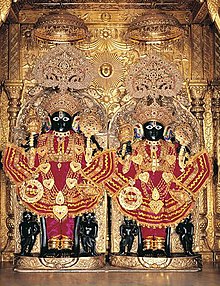Swaminarayan
[9] He is also remembered within the sect for undertaking reforms for women[10] and the poor,[11] and performing large-scale non-violent yajñas (fire sacrifices).[13] He built six mandirs to facilitate devotional worship of God by his followers,[14][15][16] and encouraged the creation of a scriptural tradition,[13][17][18] including the Shikshapatri, which he wrote in 1826.[13] Swaminarayan was born on 3 April 1781 (Chaitra Sud 9, Samvat 1837) in Chhapaiya, a village near Ayodhya, then under the Nawab of Oudh, in present-day Indian state of Uttar Pradesh.Nilkanth Varni travelled across India and parts of Nepal in search of an ashram, or hermitage, that practiced what he considered a correct understanding of Vedanta, Samkhya, Yoga, and Pancaratra.[24] To find such an ashram, Nilkanth Varni asked the following five questions on the basic Vaishnava Vedanta categories:[25] While on his journey, Nilkanth Varni mastered Astanga yoga (eightfold yoga) in a span of nine months under the guidance of an aged yogic master named Gopal Yogi.[23] In 1799, after a seven-year journey, Nilkanth's travels as a yogi eventually concluded in Loj, a village in the Junagadh district of Gujarat.[29] He later claimed in the Vachnamrut that during this period, he took up a severe penance to eliminate his mother's flesh and blood from his body so that the sign of his physical attachment to family, was completely removed.In contrast with the Vaishnava sect known as the Radha-vallabha Sampradaya,[34] he had a more puritanical approach, rather than the theological views of Krishna that are strongly capricious in character and imagery.While being a worshipper of Krishna, Swaminarayan rejected licentious elements in Krishnology in favor of worship in the mood of majesty, alike to earlier Vaishnava teachers, Ramanuja and Yamunacharya.[26][38][39] As early as 1804, Swaminarayan, who was reported to have performed miracles, was described as a manifestation of God in the first work written by a disciple and paramahamsa, Nishkulanand Swami.[45] According to Professor Raymond B. Williams, Swaminarayan was criticized because he received large gifts from his followers and dressed and traveled as a Maharaja even though he had taken the vows of renunciation of the world.[48] Swaminarayan was against the consumption of meat, alcohol or drugs, adultery, suicide, animal sacrifices, criminal activities and the appeasement of ghosts and tantric rituals.He stated that four elements need to be conquered for ultimate salvation: dharma, bhakti (devotion), gnana (knowledge) and vairagya (detachment).[4] Doctrinally, Swaminarayan was close to eleventh century philosopher Ramanuja and was critical of Adi Shankara's concept of Advaita, or monistic non-dualism.[43] Bishop Heber mentions in his account of the meeting that about two hundred disciples of Swaminarayan accompanied him as his bodyguards mounted on horses and carrying Matchlocks and swords.[75] The administrative division of his followers into two territorial dioceses is set forth in minute detail in a document written by Swaminarayan called Desh Vibhag Lekh.[25] Swaminarayan stated to all the devotees and saints to obey both the Acharyas and Gopalanand Swami who was considered as the main pillar and chief ascetic[76] for the sampradaya.He later died on 1 June 1830 (Jeth sud 10, Samvat 1886),[61] and it is believed by followers that, at the time of his death, Swaminarayan left Earth for Akshardham, his abode."[84] Professor David Harman observed that Swaminarayan "criticized the popular shakta cults and 'gosai' and 'nath' ascetics for the contemptuous and instrumental way in which they viewed and treated women.[91] Swaminarayan "forbade all sadhus and sadhvis (that is, male and female ascetics) of his sect from having any contact whatsoever with members of the opposite sex.[91][93] Members of the faith are defensive of the fact that some practices seem to restrict women and make gender equality in leadership impossible.[91] As with practices of niddah in Orthodox Judaism, concepts of pollution associated with the menstrual cycle lead to the exclusion of women from the temples and daily worship during the affected time.[96] Swaminarayan restricted widows "to live always under the control of male members of their family and prohibited them from receiving instruction in any science from any man excepting their nearest relations.[103] Reginald Heber, the Lord Bishop of Calcutta, noted that disciples of Swaminarayan cut across all castes, and even included Muslims.[114] A commentary on the practice and understanding of dharma, it is a small booklet containing 212 Sanskrit verses, outlining the basic tenets that Swaminarayan believed his followers should uphold in order to live a well-disciplined and moral life.[126][127][128] The newspaper Indian Express estimated members of the Swaminarayan sect of Hinduism to number over 20 million (2 crore) worldwide in 2007.Accused of deviating from the Vedas, his followers were criticised for the illegal collection of wealth and the "practice of frauds and tricks."[130] In the views of Dayananda, published as early as 1875, it was a "historical fact" that Swaminarayan decorated himself as Narayana in order to gain followers.[131] In 1918, Mahatma Gandhi in the letter to his nephew, expressed that Swaminarayan's values didn't align perfectly with his interpretation of Vaishnavism and the love taught by Swaminarayana was all about sentimentalism.







Swaminarayan (disambiguation)ShikshapatriChhapaiyaKingdom of OudhUttar PradeshGadhadaBaroda StateGujaratHinduismSwaminarayan SampradayaSwami RamanandasceticKrishnamanifestationPurushottamasampradayaSwaminarayan MantraahimsayajñasinstitutionalizedLaxmi Narayan Dev Gadi (Vadtal Gadi)Nar Narayan Dev Gadi (Ahmedabad Gadi)acharyasChaitraSamvatAyodhyaNawab of OudhBrahminpriestly casteRama Navamiwaxing moonSwaminarayan JayantiscripturesUpanishadsPuranasRamayanaMahabharataashramVedantaSamkhyaPancaratraIshvaraBrahmanParabrahmanAstanga yogaRana Bahadur ShahJagannath TempleBadrinathRameswaramNashikDwarkaPandharpurJunagadh districtMuktanand SwamiRamanand SwamiVachnamrutmetaphysicalepistemologicalpancha-tattvassannyasaUddhava SampradayaishtadevataVaishnavaRadha-vallabhaKrishnologyRamanujaYamunacharyamantrasamadhiNishkulanand SwamiReginald HeberBishopCalcuttaBhagavata PuranaMaharajadharmaGujaratitantricbhaktivairagyaAdi ShankaraAdvaitanon-dualismontologyThe first Swaminarayan MandirBritish Imperial GovernmentAhmedabadMuslimKathiawadChristiansMatchlocksEast India CompanySir John MalcolmGovernor of BombayBodleian LibraryUniversity of OxfordList of Swaminarayan templesSwaminarayan asceticsHindu templesRadha KrishnaNara-NarayanaLaksmi NarayanaGopinathRadha RamanaMadanamohanaVasant PanchamiJanmashtamifirst templetempleVadtalDholeraJunagadhDholkaJetalpurparamahamsassannyasiGopalanand SwamiBrahmanand SwamiGunatitanand SwamiPremanand SwamiNityanand SwamiNar Narayan Dev GadiLaxmi Narayan Dev GadiAyodhyaprasadRaghuviraKheda district
